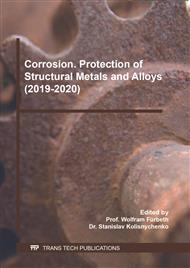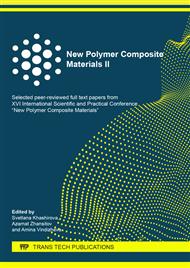[1]
Y.Li, J.Yang, J.Song, Structure models and nano energy system design for proton exchange membrane fuel cells in electric energy vehicles, Renewable and Sustainable Energy Reviews. 67 (2017) 160-172.
DOI: 10.1016/j.rser.2016.09.030
Google Scholar
[2]
T. Wilberforce, A. Alaswad, A. Palumbo, M. Dassisti, A.G. Olabia, Advances in stationary and portable fuel cell applications, International journal of hydrogen energy. 41 (2016) 16509-16522.
DOI: 10.1016/j.ijhydene.2016.02.057
Google Scholar
[3]
Y. Xu, L. Peng, P. Yi, X. Lai, Analysis of the flow distribution for thin stamped bipolar plates with tapered channel shape, International journal of hydrogen energy. 41 (2016) 5084-5095.
DOI: 10.1016/j.ijhydene.2016.01.073
Google Scholar
[4]
R.K. Gautam, S. Banerjee, K.K. Karб Bipolar plate materials for proton exchange membrane fuel cell application, Recent Patents on Materials Science. 8 (2015) 15-45.
DOI: 10.2174/1874464808666150306223104
Google Scholar
[5]
K. Feng, Y. Shen, H. Sun, D. Liu, Q. An, X. Cai, P. K.Chu, Conductive amorphous carbon-coated 316L stainless steel as bipolar plates in polymer electrolyte membrane fuel cells, International journal of hydrogen energy. 34 (2009) 6771-6777.
DOI: 10.1016/j.ijhydene.2009.06.030
Google Scholar
[6]
M. S. Vlaskin, A. V. Grigorenko, E. I. Shkolnikov, A. S. Ilyukhin, Gold-Plated Titanium Vs Carbon-Implanted Titanium As Material For Bipolar Plates In Pem Fuel Cells, Surface Review and Letters. 26 (2019) 1950038.
DOI: 10.1142/s0218625x19500380
Google Scholar
[7]
K. Feng, Z. Li, F. Lu, J. Huang, X. Cai, Y. Wu, Corrosion resistance and electrical properties of carbon/chromium–titanium–nitride multilayer coatings on stainless steel, Journal of Power Sources. 249 (2014) 299-305.
DOI: 10.1016/j.jpowsour.2013.10.103
Google Scholar
[8]
Y. Zhao, L. Wei, P. Yi, L. Peng, Influence of Cr-C film composition on electrical and corrosion properties of 316L stainless steel as bipolar plates for PEMFCs, International Journal of Hydrogen Energy. 41 (2016) 1142-1150.
DOI: 10.1016/j.ijhydene.2015.10.047
Google Scholar
[9]
T.J. Pan, X.W. Zuo, T. Wang, J. Hu, Z.D. Chen, Y.J. Ren, Electrodeposited conductive polypyrrole/polyaniline composite film for the corrosion protection of copper bipolar plates in proton exchange membrane fuel cells, Journal of Power Sources. 302 (2016) 180-188.
DOI: 10.1016/j.jpowsour.2015.10.027
Google Scholar
[10]
L. Jiang, J.A. Syed, Y. Gao, Q. Zhang, J. Zhao, H. Lu, X. Meng, Electropolymerization of camphorsulfonic acid doped conductive polypyrrole anti-corrosive coating for 304SS bipolar plates, Applied Surface Science. 426 (2017) 87-98.
DOI: 10.1016/j.apsusc.2017.07.077
Google Scholar
[11]
B.R. Caes, R.E. Teixeira, K.G. Knapp, R. T. Raines, Biomass to furanics: renewable routes to chemicals and fuels, ACS Sustainable Chemistry & Engineering. 3 (2015) 2591-2605.
DOI: 10.1021/acssuschemeng.5b00473
Google Scholar
[12]
A. Mukherjee, M. J. Dumont, V. Raghavan, Sustainable production of hydroxymethylfurfural and levulinic acid: Challenges and opportunities, Biomass and Bioenergy. 72 (2015) 143-183.
DOI: 10.1016/j.biombioe.2014.11.007
Google Scholar
[13]
P.K. Rout, A.D. Nannaware, O. Prakash, A. Kalra, R. Rajasekharan Synthesis of hydroxymethylfurfural from cellulose using green processes: A promising biochemical and biofuel feedstock, Chemical Engineering Science. 142 (2016) 318-346.
DOI: 10.1016/j.ces.2015.12.002
Google Scholar
[14]
D.V. Chernysheva, Y.A. Chus, V.A. Klushin, T. A. Lastovina, L. S. Pudova, N. V. Smirnova O. A. Kravchenko, V. M. Chernyshev, V. P. Ananikovs, Sustainable utilization of biomass refinery wastes for accessing activated carbons and supercapacitor electrode materials, ChemSusChem. 11 (2018) 3599-3608.
DOI: 10.1002/cssc.201801757
Google Scholar
[15]
V.A. Klushin, K.I. Galkin, V.P.. Kashparova, E.A. Krivodaeva, O.A. Kravchenko, N.V. Smirnova, V.M. Chernyshev, V.P. Ananikov, Technological aspects of fructose conversion to high-purity 5-hydroxymethylfurfural, a versatile platform chemical, Russian Journal of Organic Chemistry. 52 (2016) 767-771.
DOI: 10.1134/s1070428016060014
Google Scholar
[16]
DOE U. S. Fuel Cell Technologies Program: Multi-Year Research, Development, and Demonstration Plan-Planned Program Activities for 2011-2020. (2017).
Google Scholar
[17]
S.B. Lee, K.H. Cho, W.G. Lee, H. Jang, Improved corrosion resistance and interfacial contact resistance of 316L stainless-steel for proton exchange membrane fuel cell bipolar plates by chromizing surface treatment, Journal of Power Sources. 187 (2009) 318-323.
DOI: 10.1016/j.jpowsour.2008.11.064
Google Scholar
[18]
E.J. Kelly, Electrochemical Behavior of Titanium, Modern Aspects of Electrochemistry, ed. by J. O 'M. Bockris et al., Plenum Press, New York. 14 (1982) 319-424.
Google Scholar
[19]
K. Feng, Z. Li, F. Lu, J. Huang, X. Cai, Y. Wu, Corrosion resistance and electrical properties of carbon/chromium–titanium–nitride multilayer coatings on stainless steel, Journal of Power Sources. 249 (2014) 299-305.
DOI: 10.1016/j.jpowsour.2013.10.103
Google Scholar
[20]
J.L. Brédas, R. Silbey (Eds.), Conjugated polymers: the novel science and technology of highly conducting and nonlinear optically active materials. Springer Science & Business Media, (2012).
DOI: 10.1007/978-94-011-3476-7
Google Scholar



